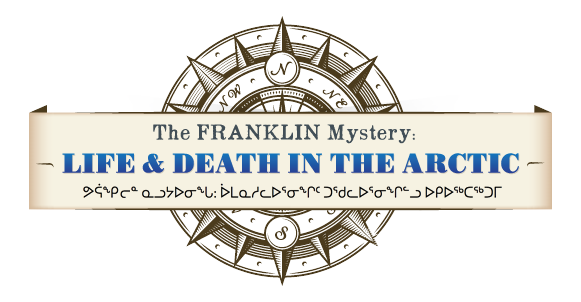The Mysteries of the Franklin Expedition
Welcome.
In 1845, HMS Erebus and HMS Terror set sail from England under the command of Sir John Franklin. Their mission: to explore the Canadian Arctic in search of the Northwest Passage, a cheaper and safer route for trading goods, including silk and spices, with China. The mission was also a scientific one: they were seeking a better understanding of geomagnetic science as they traveled near the earth’s northern magnetic pole. We do not know if they succeeded: both ships and the entire party of 129 men disappeared into the Canadian Arctic and never returned. The Franklin Mystery: Life and Death in the Arctic, gives you what you need – the real historical evidence left over from those terrible events - to find out why.
The disappearance of Franklin`s Arctic Expedition immediately sparked one of the most extensive search efforts in world history. Thirty-two expeditions from Britain and the United States were engaged in the search for Franklin between 1847 and 1859. As grisly details about the expedition’s untimely end began to trickle in from these search and rescue operations, the public’s intrigue turned to horror. For the next 160 years people around the world have considered that evidence and pondered the fate of Franklin's men and their two ships. And it isn’t over. In 2010, the government of Canada launched a new search, using the latest underwater exploration technologies, for the missing ships, Erebus and Terror. In 2014 the expedition led by Parks Canada succeeded in finding the wreck of HMS Erebus in the Queen Maud Gulf at the bottom of the ocean. This exciting new find offers the potential to answer many questions relating to the expedition in the years ahead.
The researcher team returned to the Arctic the following year. When an expedition led by Parks Canada continued searching in 2016, the Arctic Research Foundation team travelling on the research vessel Martin Bergmann discovered the well-preserved wreck of the HMS Terror near King William Island. These exciting new finds offer the potential to answer many questions relating to the expedition in the years ahead. For the latest on this search visit The Mystery Continues page.
There is new scientific evidence as well, ranging from data from underwater submarines to forensic evidence from the skeleton remains and the remarkable discoveries of the remains of HMS Erebus in September 2014 and the HMS Terror in September 2016.
There are other mysteries here. How could the best-equipped scientific mission from the world’s most technically advanced industrial country – and Franklin’s third trip to the Arctic – flounder? The Inuit, many of whom were in the immediate vicinity of Franklin’s ill-fated voyage at the time, thrived in that same Arctic environment, and had done so for thousand of years. The Franklin Mystery: Life and Death in the Arctic will provide you with a window on Inuit life, allowing you to explore not only the environments in which the members of the Franklin expedition died, but how and why Inuit have been able to live there successfully for so long.
The Franklin Mystery: Life and Death in the Arctic invites you to explore the historical evidence about those tragic events, and come to your own conclusions about what happened, and why. You will find here hundreds of pieces of evidence left over from the past and reproduced here in letters, diaries, memoirs, drawings, paintings and maps. There is new scientific evidence as well, ranging from data from underwater submarines to forensic evidence from the skeleton remains and the remarkable discovery of the remains of HMS Erebus in September 2014. You will also read Inuit oral history evidence from the nineteenth century. What role did their statements play in finding the remains of the Expedition? How did Inuit knowledge of the Arctic environment aid the searchers? Was it possible that they encountered Franklin’s men before their grim deaths?


